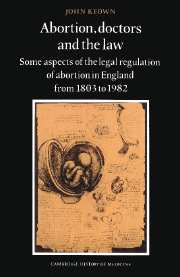 Abortion, Doctors and the Law
Abortion, Doctors and the Law Book contents
- Frontmatter
- Contents
- Table of cases
- Table of statutes
- Acknowledgements
- Introduction
- 1 The first statutory prohibition of abortion: Lord Ellenborough's Act 1803
- 2 Anti-abortion legislation 1803–1861 and medical influence thereon
- 3 Abortion in legal theory and medical practice before 1938
- 4 The medical profession and the enactment of the Abortion Act 1967
- 5 The Abortion Act 1967 and the performance of abortion by the medical profession 1968–1982
- 6 The reaction of the medical profession to proposed restriction of the law 1969–1979
- 7 A theoretical overview
- Appendices
- Notes
- Subject index
- Names index
1 - The first statutory prohibition of abortion: Lord Ellenborough's Act 1803
Published online by Cambridge University Press: 26 October 2009
- Frontmatter
- Contents
- Table of cases
- Table of statutes
- Acknowledgements
- Introduction
- 1 The first statutory prohibition of abortion: Lord Ellenborough's Act 1803
- 2 Anti-abortion legislation 1803–1861 and medical influence thereon
- 3 Abortion in legal theory and medical practice before 1938
- 4 The medical profession and the enactment of the Abortion Act 1967
- 5 The Abortion Act 1967 and the performance of abortion by the medical profession 1968–1982
- 6 The reaction of the medical profession to proposed restriction of the law 1969–1979
- 7 A theoretical overview
- Appendices
- Notes
- Subject index
- Names index
Summary
This chapter focusses, against the background of the common-law offence of abortion, on the enactment of the first statutory prohibition of abortion in Lord Ellenborough's Act 1803 (43 Geo III c. 58).
Abortion and the common law
During the late seventeenth, the whole of the eighteenth, and early nineteenth centuries, English and American women were totally free from all restraints, ecclesiastical as well as secular, in regard to the termination of unwanted pregnancies, at any time during gestation.
(Cyril C. Means Jr)Abortion and the ecclesiastical courts 1200–1600
Whether the common law prohibited the destruction of unborn life has been, and remains, a controversial question, an exhaustive examination of which would be beyond the scope of this chapter. However, it will be contended here, pace Professor Means, that the weight of available authority supports the view that the common law prohibited abortion, at the latest, after the fetus had become ‘quick’ or ‘animated’. Animation was believed to occur when the fetus ‘quickened’ in the womb. An incident of the second trimester of pregnancy, quickening marks the first maternal perception of fetal movement. In associating the origin of life with quickening, the law betrayed both pragmatic and metaphysical influences. The former concerned the need to prove, in any prosecution for abortion, that the woman had been pregnant and that the fetus had been killed by the abortifacient act. Evidence of quickening would clearly facilitate prosecution. The metaphysical influence upon the law was the popular theory, originated by Aristotle and perpetuated by Galen, that human life began at the point of ‘animation’.
- Type
- Chapter
- Information
- Abortion, Doctors and the LawSome Aspects of the Legal Regulation of Abortion in England from 1803 to 1982, pp. 3 - 25Publisher: Cambridge University PressPrint publication year: 1988
- 2
- Cited by


